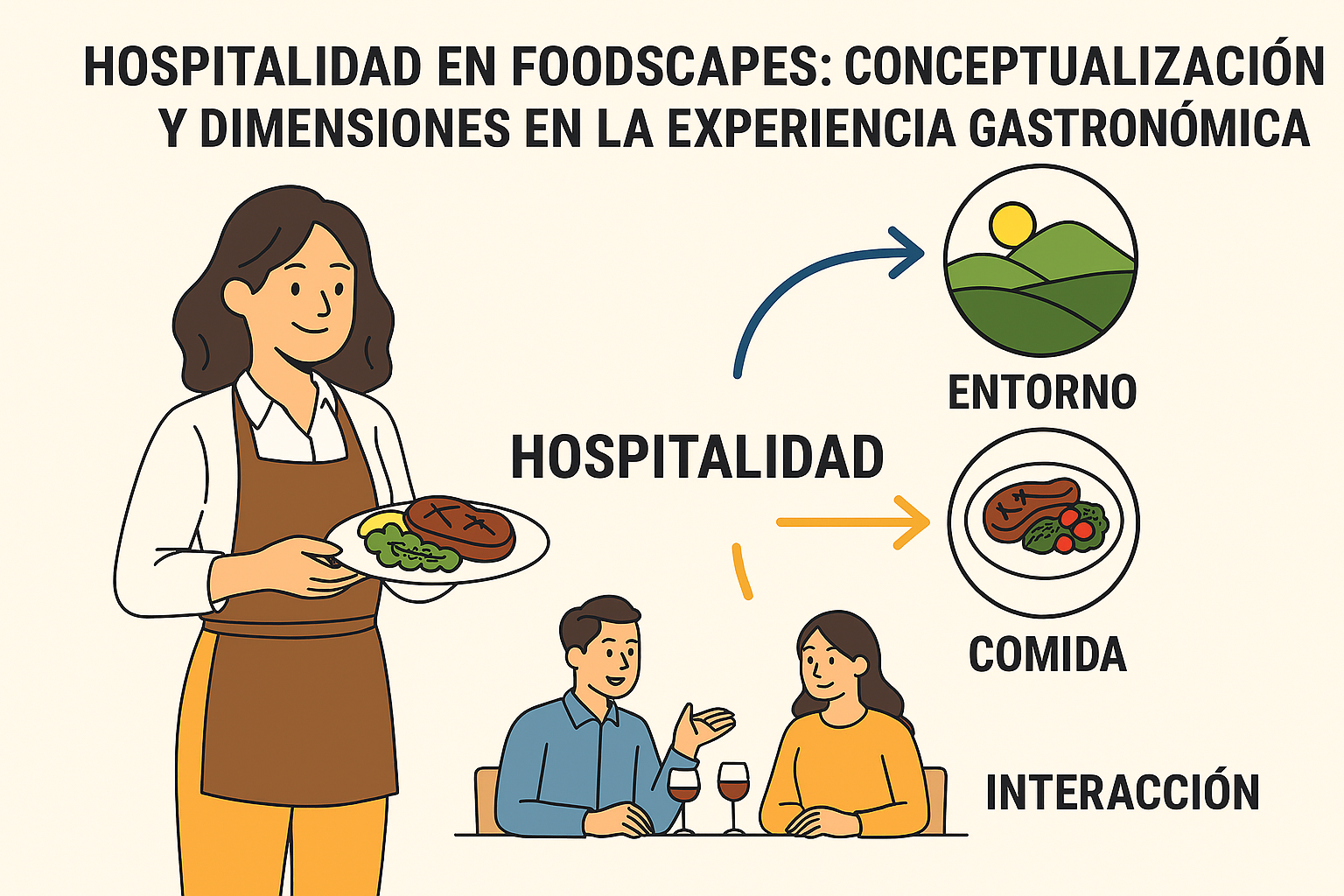HOSPITALITY IN FOODSCAPES, CONCEPTUALIZATION AND DIMENSIONS OF THE DINING EXPERIENCE
DOI:
https://doi.org/10.56124/sapientiae.v8i18.008Keywords:
sustainable development, virtual tourist guide, innovation.Abstract
From its beginnings, hospitality has been defined as the relationship between host and visitor, characterized by welcome, care and the offer of lodging and food mainly. However, in the context of culinary landscapes or foodscapes, this definition is broadened to include not only the interaction between people, but also the arrangement of the space, the differentiation of the gastronomic proposal and the general atmosphere experienced in the moments of such interaction.
This research analyzes how hospitality manifests itself in these environments, identifying symbolic, emotional, spatial and functional dimensions. A qualitative methodology with an interpretative and contextual approach was used, through an exploratory and analytical documentary review, based on validated academic sources. This approach made it possible to examine the state of the art, identify key conceptualizations and systematize relevant findings on the subject.
Expressions of hospitality in foodscapes are grouped into three main approaches. First, performative and relational hospitality, understood as a situated practice where hosts and diners co-create experiences through gestures, rituals and culinary narratives (Lugosi, 2008). Second, the meal as a symbolic act of welcoming, sharing food as a form of cultural inclusion and intercultural understanding (Richards, 2012). Third, the design of the space and atmosphere, where elements such as decoration, lighting, music and layout influence the diner's perception (Blichfeldt et al., 2013). Sims (2009) reinforces these perspectives by pointing out that local cuisine functions as a tourism differentiation strategy, especially in emerging destinations. Taken together, these approaches show that hospitality in foodscapes transcends commercial service, constituting a key form of social and cultural relationship to design more meaningful tourism experiences committed to local development.
Downloads
References
Ayora-Díaz, S. I. (2012). Foodscapes, foodfields and identities in Yucatán. Amsterdam: CEDLA.
Bell, D. (2009). Tourism and hospitality: Towards a critical research agenda. Tourist Studies, 9(2), 147–152. https://doi.org/10.1177/1468797609360590
Bitner, M. J. (1992). Servicescapes: The impact of physical surroundings on customers and employees. Journal of Marketing, 56(2), 57–71. https://doi.org/10.1177/002224299205600205
Blichfeldt, B. S., Lundberg, C., & Morales, M. (2013). Atmosphere in hospitality settings: A guest–host perspective. International Journal of Contemporary Hospitality Management, 25(5), 646–661. https://doi.org/10.1108/IJCHM-05-2012-0076
Contreras, J. (1993). Antropología de la alimentación. Madrid: Eudema.
Han, H., & Ryu, K. (2009). The roles of the physical environment, price perception, and customer satisfaction in determining customer loyalty in the restaurant industry. Journal of Hospitality & Tourism Research, 33(4), 487–510. https://doi.org/10.1177/1096348009334420
Johnston, J., & Baumann, S. (2015). Foodies: Democracy and distinction in the gourmet foodscape. Routledge.
Lashley, C. (2000). Hospitality and Tourism: A Critical Introduction. Butterworth Heinemann.
Lashley, C. (2000). Hospitality provision in the service sector: Themes and perspectives. Butterworth-Heinemann.
Lugosi, P. (2008). Hospitality spaces, hospitable moments: Consumer encounters and affective experiences in commercial settings. Journal of Foodservice, 19(2), 139–149. https://doi.org/10.1111/j.1745-4506.2008.00091.x
Lynch, P., Molz, J. G., McIntosh, A., Lugosi, P., & Lashley, C. (2011). Theorizing hospitality. Hospitality & Society, 1(1), 3–24. https://doi.org/10.1386/hosp.1.1.3_1
Park, S., Hwang, D., Lee, W. S., & Heo, J. (2018). Influence of nostalgia on authenticity, satisfaction, and revisit intention: The case of Jidong mural alley in Korea. International Journal of Hospitality & Tourism Administration.21(1):1-17. https://doi.org/10.1080/15256480.2018.1511497
Pijls, R., Groen, B. H., Galetzka, M., & Pruyn, A. T. H. (2017). Measuring the experience of hospitality: Scale development and validation. International Journal of Hospitality Management. 67, 125–133. https://doi.org/10.1016/j.ijhm.2017.08.010
Ramos-Ruiz, J. E., Aguilar-Rivero, M., Castaño-Prieto, L., & López-Guzmán, T. (2024). Sabores y sensaciones: Análisis de la experiencia gastronómica de los turistas y su relación con el perfil sociodemográfico. Revista de Estudios Empresariales. Segunda época, (2), 57–73. https://doi.org/10.17561/ree.n2.2024.8785
Richards, G. (2012). An overview of food and tourism trends and policies.
Sims, R. (2009). Food, place and authenticity: Local food and the sustainable tourism experience. Journal of Sustainable Tourism, 17(3), 321–336. https://doi.org/10.1080/09669580802359293
Telfer, E. (2000). The philosophy of hospitableness. In C. Lashley & A. Morrison (Eds.), In search of hospitality: Theoretical perspectives and debates (pp. 38–55). Butterworth-Heinemann.

Published
How to Cite
Issue
Section
License
Copyright (c) 2025 Revista Científica Multidisciplinaria SAPIENTIAE. ISSN: 2600-6030.

This work is licensed under a Creative Commons Attribution-NonCommercial-ShareAlike 4.0 International License.

2.jpg)


















